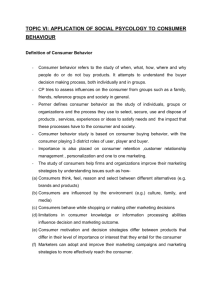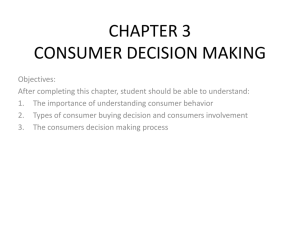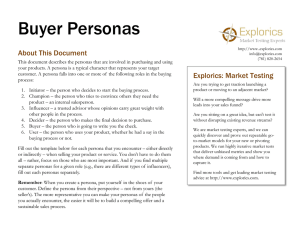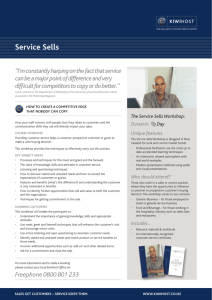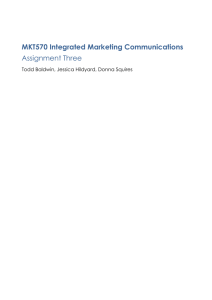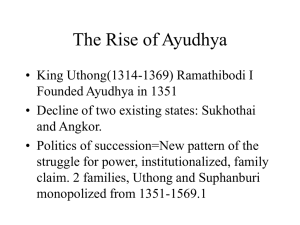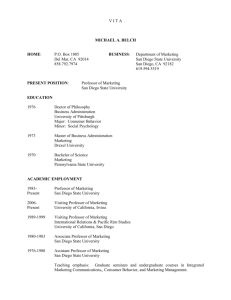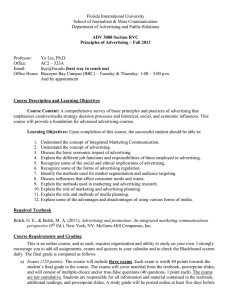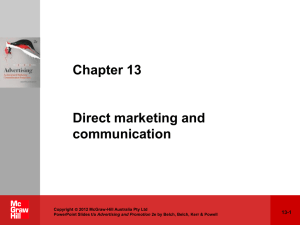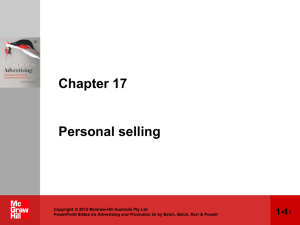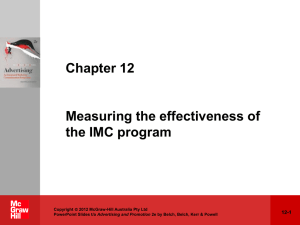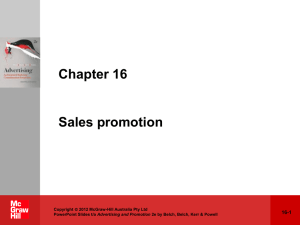Service marketing mix factors affecting customers
advertisement
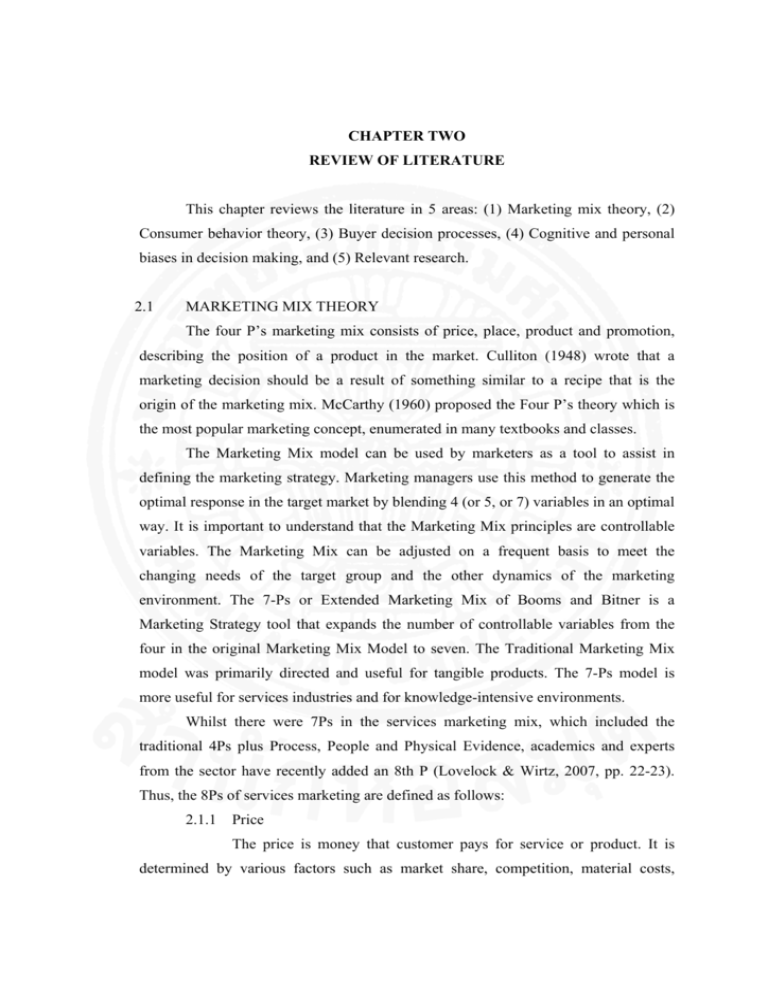
CHAPTER TWO REVIEW OF LITERATURE This chapter reviews the literature in 5 areas: (1) Marketing mix theory, (2) Consumer behavior theory, (3) Buyer decision processes, (4) Cognitive and personal biases in decision making, and (5) Relevant research. 2.1 MARKETING MIX THEORY The four P’s marketing mix consists of price, place, product and promotion, describing the position of a product in the market. Culliton (1948) wrote that a marketing decision should be a result of something similar to a recipe that is the origin of the marketing mix. McCarthy (1960) proposed the Four P’s theory which is the most popular marketing concept, enumerated in many textbooks and classes. The Marketing Mix model can be used by marketers as a tool to assist in defining the marketing strategy. Marketing managers use this method to generate the optimal response in the target market by blending 4 (or 5, or 7) variables in an optimal way. It is important to understand that the Marketing Mix principles are controllable variables. The Marketing Mix can be adjusted on a frequent basis to meet the changing needs of the target group and the other dynamics of the marketing environment. The 7-Ps or Extended Marketing Mix of Booms and Bitner is a Marketing Strategy tool that expands the number of controllable variables from the four in the original Marketing Mix Model to seven. The Traditional Marketing Mix model was primarily directed and useful for tangible products. The 7-Ps model is more useful for services industries and for knowledge-intensive environments. Whilst there were 7Ps in the services marketing mix, which included the traditional 4Ps plus Process, People and Physical Evidence, academics and experts from the sector have recently added an 8th P (Lovelock & Wirtz, 2007, pp. 22-23). Thus, the 8Ps of services marketing are defined as follows: 2.1.1 Price The price is money that customer pays for service or product. It is determined by various factors such as market share, competition, material costs, 7 product desirability and customer satisfaction. The price may be increased or decreased depending on the demand and supply in the market. 2.1.2 Place Place is the location where product or service can be purchased. It is often related to a sale channel, physical or virtual, such as a bank’s branches or a website. 2.1.3 Product Product or service can be mass produced or specifically manufactured. For example, the hotel industry is generally a mass produced service; a car is a mass produced product; a database application is a specific product. 2.1.4 Promotion Promotion has four outstanding components – advertising, public relations, word of mouth and point of sale (POS). It is marketers’ communications to consumers that they may use in the market. Firstly, advertising includes any communication from television, radio, internet, billboards, print media and cinema commercials for which the advertiser has paid a fee to be included in the media. Secondly, public relations efforts are indirectly paid for, and include sponsorship deals, exhibitions, conferences, seminars or trade events. Thirdly, word of mouth is any informal communication about product or service by ordinary individuals, satisfied customers or people specifically engaged to create word of mouth. 2.1.5 People An essential ingredient to any service provision is the use of appropriate staff and people. Recruiting the right staff and training them appropriately in the delivery of their service is essential if the organization wants to obtain a form of competitive advantage. Consumers make judgments and deliver perceptions of the service based on the employees they interact with. Staff should have the appropriate interpersonal skills, aptitude, and service knowledge to provide the service that consumers are paying for. 2.1.6 Process Process refers to the systems used to assist the organization in delivering the service. For example, Banks that send out Credit Cards automatically when their customer’s old one has expired again require an efficient process to 8 identify expiry dates and renewal. An efficient service that replaces old credit cards will foster consumer loyalty and confidence in the company. 2.1.7 Physical Evidence Physical evidence is the overall layout of the place i.e. how the entire bank has been designed. It refers to all factors that help make the process much easier and smoother. Within the new marketing mix structure, physical evidence refers to whatever customers can see before purchasing. This can include the physical environment, packaging, supporting collateral and anything else that helps in presentation. Physical evidence as one of the components of the marketing mix is most useful in selling and marketing services and intangible products. Physical evidence within the marketing mix structure should be tied into trying to understand the customer's perspective. 2.1.8 Productivity and Quality Improving productivity is a requisite in cost management; but quality, as defined by the customer, is essential for a service to differentiate itself from other providers. (Lovelock & Wirtz, 2007). Productivity relates to how inputs are transformed into outputs that are valued by customers, whereas quality refers to the degree to which a service satisfies customers by meeting their needs, wants, and expectations. Improving productivity is essential to keep costs under control, but managers must beware of making inappropriate cuts in service levels that are resented by customers. Service quality is essential for product differentiation and building customer loyalty. However, investing in quality improvement without understanding the tradeoff between incremental costs and incremental revenues may hurt profitability. 2.2 CONSUMER BEHAVIOR THEORY Consumer behavior is the study of how people buy, what they buy, when they buy and why they buy. This theory attempts to explain the buyer decision making process both individually and in groups. It studies characteristics of individual consumers to explain customers’ needs. Moreover, it explains the effects of influences such as family, friends, reference groups, and society in general. G.E. Belch and M.A. Belch (2004) define consumer behavior as ‘the process and activities people 9 engage in when searching for, selecting, purchasing, using, evaluating, and disposing of products and services so as to satisfy their needs and desires. A five-stage model of the consumer buying process (Kotler, 2003) explains the basic model of consumer decision making according to Table 1. Table 1. Basic Model of Consumer Buying Process Stage Brief description Feeling Problem The consumer perceives a need and becomes recognition motivated to solve a problem. Information The consumer searches for information required Perception search to make a purchase decision. Information The consumer compares various brands and Attitude evaluation products. formation Purchase decision The consumer decides which brand to purchase. Integration Post-purchase The consumer evaluates their purchase Learning evaluation decision. 2.2.1 Motivation Problem Recognition When there is a difference between the actual stage and the desired stage, the result is problem recognition. For examples, an item which is out of stock may cause a customer to feel dissatisfied with a current service. Therefore, the customer will find other products instead. 2.2.2 Information Search When consumers have recognized a problem, they will search for more information related to products/services that can help them. They will search for information from internal and external sources, as explained by G. E. Belch and M. A. Belch (2004). Firstly, internal sources are associated with personal perception, consumer attitude and experience. If the internal information is not sufficient, consumers will search external sources for more information. Secondly, external sources are related to public or commercial sources such as friends, family, and commercial advertising. 10 2.2.3 Information Evaluation At this stage, consumers can analyze alternative products or services that they researched in the previous stage. They evaluate functional and psychological benefits that products or services can provide them. Consumers’ attitudes are associated with the alternative evaluation stage, which is related to internal psychological processes. Attitudes describe what people think and how they feel about something. 2.2.4 Purchase Decision After consumers have evaluated all alternatives, they are ready to make decisions about whether to purchase products or services. Purchase intention is not always an actual purchase, so the marketer must stimulate the consumers to act, by means of strategies such as sales promotions, special discounts, or free premiums. The relevant internal psychological strategy should be integrated to purchase decision making. 2.2.5 Post-purchase Evaluation The purchase is not the end of consumers’ buying products or services; information after sales should also constitute feedback to the provider. The marketer can analyze customers’ satisfaction, and whether they will re-purchase. Moreover, this is a good opportunity to improve products or services. 2.3 BUYER DECISION PROCESSES Buyer decision processes are the purchase decision made by consumers who consider products or services before, during and after the purchase processes. AIUAPR – Awareness, Interest, Understanding, Attitudes, Purchase and Repeat purchase – explained by Mercer (2008) is a simple model explaining that consumers cannot repeatedly purchase without the previous stages of creating products’ or services’ awareness and convincing consumers to engage in trial use. 2.3.1 Awareness The marketer should gain the attention of the potential customers to become aware that the products or services exist before anything can happen. If the customers never know of the products, they can not respond in any way. 2.3.2 Interest 11 The message not only must grab customers’ attention, but it must be interesting. Also, it must persuade customers to purchase products or services related to their needs. Good messages clearly and meaningfully answer customers’ needs. 2.3.3 Understanding Once interest is established, the prospective customers must be able to appreciate that the offering may meet their needs. Advertising is one important tool to achieve customer understanding. 2.3.4 Attitudes The message must persuade audiences to hold a positive attitude towards services or products they are interested in. The advertisement should focus on the strength of services or products. 2.3.5 Purchase While customers are considering the advertisement, they may feel the above four stages – awareness, interest, understanding and attitudes – in a few minutes. However, the purchase decision making may take more time because they may compare information before making the purchase. 2.3.6 Repeat Purchase The actual success is not only the first purchase but also the repeating of it. How to ask consumers to re-purchase is a significant challenge for business. This stage is the most difficult stage creating a customers’ loyalty to a brand. 2.4 COGNITIVE AND PERSONAL BIASES IN DECISION MAKING It is normal that biases can occur during people’s decision making processes. France (2008) explained some common cognitive biases as follows: 1. Selective information: People tend to accept only information that supports their conclusion but they refuse other facts that support different conclusions. 2. Quick termination of search for more information: People tend to stop searching for more information when they accept the first alternative that looks good. 3. Inactivity: Some people are unwilling to change their thought despite new evidence. 4. Experiential limitation: Some people are unwilling to think beyond past experiences or accept unfamiliar information. 12 5. Selective perception: Some people ignore information because it is not immediately outstanding. 6. Optimism: People tend to notice only positive situations. 7. Recent information: People tend to pay attention on more recent information and ignore other information. 8. Repetition bias: People tend to believe what they have been informed most often and items repeated from different sources. 9. Anchoring: People’s decisions are overly influenced by initial information that shapes their point of view of the next information. 10. Group think: Some people follow group opinion. 11. Source credibility bias: People tend to accept information by someone they like and reject information from someone they dislike. 12. Incremental decision making and escalating commitment: People tend to continue a series of similar decisions, correcting themselves incrementally, as opposed to zero-based decision making. 13. Inconsistency: People are unwilling to apply the same decision criteria in similar situations. 14. Attribution asymmetry: People tend to declare their success are due to their abilities and talents, but they point to their failures as bad luck and external factors. On the other hand, they ascribe others’ success to good luck, and others’ failures to mistakes. 15. Underestimating uncertainty: People tend to underestimate future uncertainty because they believe they have more control over events than they do. 16. Faulty generalizations: People tend to group people or objects together because they need to simplify an extremely complex world. This may cause bias in the decision making processes. 17. Ascription of causality: People tend to conclude cause when the evidence only suggests correlation. For example, just because birds fly to the equatorial regions when the trees lose their leaves, it does not mean that the birds migrate because the trees lose their leaves. 13 2.5 RELEVANT RESEARCH Previous research investigated the factors affecting consumers’ decision making when buying products or services using factors such as product, price, place, promotion etc. Narumol Santhawaree (นฤมล สันธวารี, 2551) found that respondents evaluate ATM usage in terms of service quality. For the financial service providers, it is important to understand the attributes that are based on the customer evaluation; whether they have a positive or negative effect on service quality. Financial service providers need to learn the important aspects of customer self-service and how these relate to their customers and the overall service level. In the study, it is apparent that aspects of location, ease of use, speed and reliability need to be considered. Financial services providers need to struggle for excellence in these aspects as well as be able communicate their benefits. The result implies that the retail banks should be concerned with ATM crime and ATM surcharges in the long run. Rujira Laosuppermpul (2003) studied the degree of satisfaction with services of the headquarters of Bank of Ayudhya. The respondents consisted of 200 customers receiving services from the headquarters of the Bank of Ayudhya Public Company Limited. The researcher used questionnaires to collect data. The findings were as follows: 1) the customers of the bank are mostly female, aged between 31-40 years old with a bachelor’s degree; 2) the researcher also indicated that a lot of customers were satisfied with the level of services provided by the bank, including the security system, the dress, the new technologies and the variety of services in financial transactions; 3) some customers were dissatisfied with the bank officers because of the low level of eagerness, immediate service provision and the lack of politeness. The researcher’s study also showed that the level of education of the customers really affected the level of satisfaction the customers had toward the services of the bank. The study of Pramoch Rodchumras (1997) in “The Buying Behavior of Consumers Towards the 7-eleven Enterprise in Bangkok Metropolitan” showed that customers who frequent 7-eleven convenient stores in Bangkok were young people with little or no salary. They shopped there because the shops were easily approached, and not too crowded. The shops also provided necessary goods and food in daily life. Women frequented 7-elevens more than men did. 14 Another study was conducted by Supinda Thirawarapich (สุพินดา ธีรวราพิชญ, 2544). It was aimed at comparing the quality of service provided between Thai Farmer Bank and Housing Bank at Siam Square branch. Parts of the results showed that good service provision came from a positive attitude of the service providers themselves. However, they needed to be more optimistic with their job and with their customers as well. For this study, the focus is on how much the customers are satisfied with its customer services. The outcome will be a useful and effective mirror for the banks’ staff to assess themselves as to their effectiveness in dealing with customers when any problem occurs in the branches. As a result, they can improve their service provision afterwards in order to keep their jobs and help the banks succeed.

